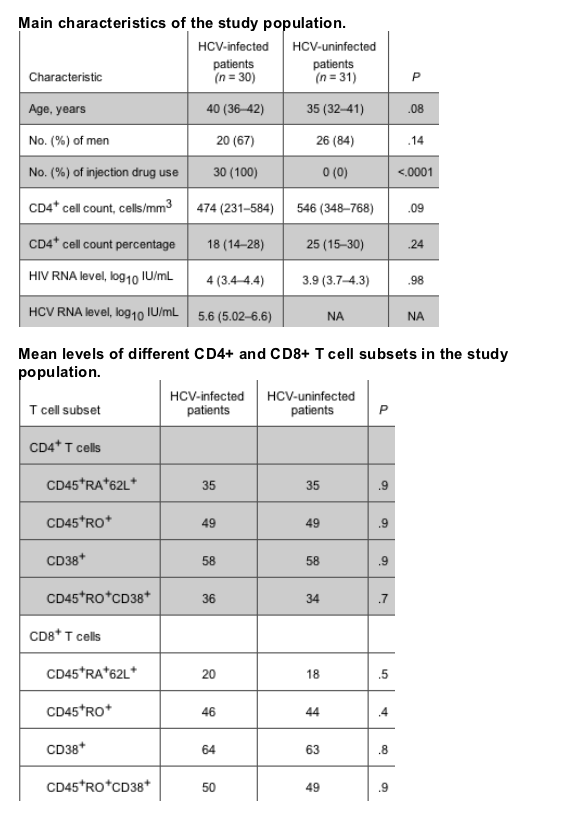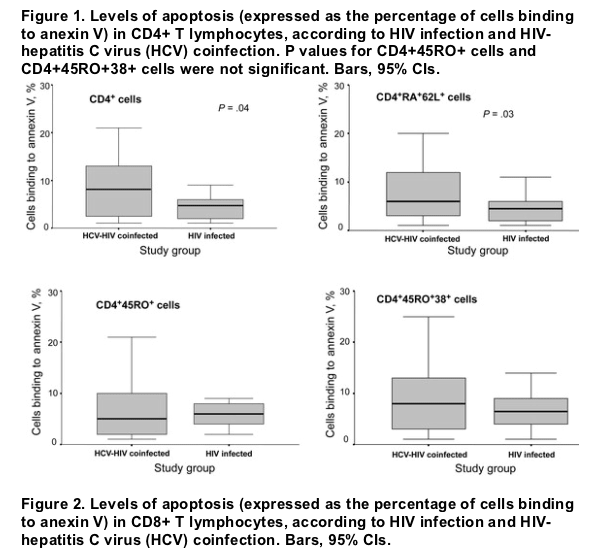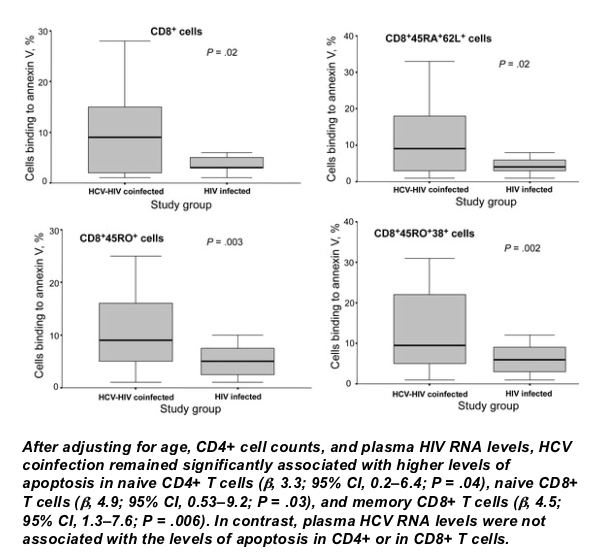| |
Coinfection with Hepatitis C Virus Increases Lymphocyte Apoptosis in HIV-Infected Patients
|
| |
| |
Clinical Infectious Diseases Nov 1, 2006;43:1209-1212
BRIEF REPORT
Marina Nunez,a Vincent Soriano, Mariola Lopez, Celia Ballesteros, Almudena Cascajero, Juan Gonzalez-Lahoz, and Jose Miguel Benito
Department of Infectious Diseases, Hospital Carlos III, Madrid, Spain
To test the role of hepatitis C virus (HCV) in CD4 cell depletion in human immunodeficiency virus (HIV)-coinfected patients, T cell apoptosis was measured by annexin V labeling in 31 HIV-infected and 30 HIV-HCV-coinfected patients who were not receiving antiretroviral therapy. Apoptosis in naive CD4+ T cells and in naive and memory CD8+ T cells was significantly higher in HIV-HCV-coinfected than in monoinfected patients.
"....After adjusting for age, CD4+ cell counts, and plasma HIV RNA levels, HCV coinfection remained significantly associated with higher levels of apoptosis in naive CD4+ T cells (b, 3.3; 95% CI, 0.2-6.4; P = .04), naive CD8+ T cells (b, 4.9; 95% CI, 0.53-9.2; P = .03), and memory CD8+ T cells (b, 4.5; 95% CI, 1.3-7.6; P = .006). In contrast, plasma HCV RNA levels were not associated with the levels of apoptosis in CD4+ or in CD8+ T cells..... HCV coinfection is associated with increased apoptosis of T lymphocytes in HIV-infected patients. This effect could have a negative impact on CD4+ T cell homeostasis in HCV-HIV-coinfected patients, explaining the more pronounced decreases in the CD4+ cell count and blunted CD4+ cell count recoveries observed while patients are receiving HAART, as well as facilitating HCV immune escape in this population."
(Note from Jules Levin: this makes a case for treating HCV first).
Lower CD4 cell counts and reduced CD4+ cell count gains after initiating HAART in HIV-infected patients who also are infected with hepatitis C virus (HCV), compared with HIV-monoinfected individuals, have been reported [1-6]. Nevertheless, the mechanism by which HCV could cause CD4+ T cell depletion is so far unclear. In HIV infection, increased lymphocyte apoptosis has been proposed as a mechanism for CD4+ T cell loss [7]. On the other hand, infection of peripheral blood mononuclear cells with HCV seems to correlate with Fas-mediated apoptosis in patients with chronic hepatitis C [8]. Accordingly, it is reasonable to presume that HCV and HIV might act synergistically, thereby increasing lymphocyte apoptosis in coinfected patients. To prove this hypothesis, we measured and compared the levels of apoptosis in T lymphocytes in HIV-monoinfected and HIV-HCV-coinfected subjects.
Patients and methods. HIV-infected patients who were not receiving antiretroviral therapy for at least 6 months were identified at the HIV clinic of Hospital Carlos III, Madrid (Spain). The presence or absence of active HCV coinfection, defined as detectable plasma HCV RNA, was established for all patients. Demographic characteristics, plasma HIV RNA and HCV RNA levels, and CD4 cell counts were recorded.
Levels of naive (CD45RA+62L+), memory (CD45RO+), activated (CD38+), and memory-activated (CD45RO+CD38+) CD4+ and CD8+ T cells were measured using 4-color flow cytometry. Levels of apoptosis were examined in different subsets of CD4+ and CD8+ T lymphocytes, ex vivo, in whole blood, by annexin V labeling, using a commercially available kit (Coulter). Annexin V-FITC/propidium iodide stain was used to exclude late apoptotic and/or necrotic cells (positive for both cells) from the analysis.
Student's t test and the x2 test were used for comparison of variables between groups. Univariate and multivariate linear regression analyses were performed to assess factors potentially associated with the levels of apoptosis. Statistically significant differences were considered when P values were <.05. All analyses were performed using the SPSS software, version 9.0 (SPSS).
Results. Sixty-one HIV-infected patients were analyzed, 31 of whom were HIV monoinfected and 30 of whom were HIV-HCV coinfected. The main characteristics of the study population are shown in table 1. Age tended to be greater and CD4+ cell counts tended to be lower in HCV-HIV-coinfected subjects than in HIV-monoinfected subjects. All coinfected patients acquired HIV and HCV infection through injection drug use, whereas all HIV-monoinfected individuals were infected through sexual contact. Among HIV-HCV-coinfected patients, the most common HCV genotype was HCV-1, followed by HCV-3. Levels of apoptosis in memory (CD45RO+) and naive (CD45RA+CD62L+) subsets of CD4+ and CD8+ T lymphocytes, as well as their level of activation (CD38+), were similar in HIV-monoinfected and in HIV-HCV-coinfected patients (table 2).

The levels of apoptosis in the whole population of CD4+ T cells and in their naive subset were significantly higher in HIV-HCV-coinfected than in HIV-monoinfected patients (figure 1). Moreover, total CD8+ T cells and their naive and memory subsets showed significantly higher levels of apoptosis in HIV-HCV-coinfected than in HIV-monoinfected patients (figure 2).


After adjusting for age, CD4+ cell counts, and plasma HIV RNA levels, HCV coinfection remained significantly associated with higher levels of apoptosis in naive CD4+ T cells (b, 3.3; 95% CI, 0.2-6.4; P = .04), naive CD8+ T cells (b, 4.9; 95% CI, 0.53-9.2; P = .03), and memory CD8+ T cells (b, 4.5; 95% CI, 1.3-7.6; P = .006). In contrast, plasma HCV RNA levels were not associated with the levels of apoptosis in CD4+ or in CD8+ T cells.
Discussion. More-pronounced CD4+ T cell loss and blunted CD4+ cell reconstitution following initiation of HAART have both been reported in HIV-HCV-coinfected patients, compared with HIV-monoinfected individuals [1-6]. These findings, however, have not been confirmed by others [9-11]. Increased apoptosis has been proposed as a mechanism to explain CD4+ T cell depletion in HIV infection, and lymphocytes may also be infected with HCV [7, 12], supporting a role for deleterious synergism in the setting of HCV-HIV coinfection. Because HCV proteins may induce apoptosis in cells other than hepatocytes (including liver and peripheral lymphocytes) [13-16], and infection of PBMCs with HCV has been shown to correlate with Fas-mediated apoptosis [8], our observation of an increased level of apoptosis in CD4+ and CD8+ T cells in HCV-HIV-coinfected patients (compared with HIV-monoinfected individuals) is relevant. It provides a plausible mechanism to explain lower CD4+ cell counts and impaired CD4+ cell recovery during HAART in HCV-HIV-coinfected versus HIV-monoinfected patients.
In HIV infection, the level of T cell apoptosis is generally correlated with the level of HIV-driven immune activation [17]. However, in our group of HIV-HCV-coinfected patients, activation of CD4+ and CD8+ T cells was similar to that observed in HIV-monoinfected subjects, although the levels of apoptosis were higher in the former group. In fact, we did not find any association between T cell activation and T cell apoptosis in coinfected patients (data not shown). This suggests that lymphocyte apoptosis in coinfected patients is not directly dependent of T cell activation, and that other mechanisms might be involved in the enhanced level of apoptosis observed in this population. In agreement with our findings, only T cells expressing HCV RNA show increased expression of Fas, a protein involved in the induction of apoptosis [8].
Another relevant consequence of an increased apoptosis of T lymphocytes in HCV-HIV-coinfected versus HIV-monoinfected individuals could be related to its contribution to escaping HCV-specific immune responses [18]. HCV-specific T cell responses are weak in patients who have chronic HCV infection [19], and they are even more impaired when HIV coinfection is present [20]. It has been proposed that the immunosuppression associated with HIV infection accounts for the lower HCV-specific immune responses observed in HCV-HIV-coinfected patients. However, our results support the hypothesis that enhanced apoptosis of HCV-specific CD4+ and CD8+ T cells in HIV-infected patients might also contribute to this phenomenon. Interestingly, apoptosis of CD4+ T cells in our study was especially increased in naive cells, a subset that plays a pivotal role in generating immune responses against newly encountered epitopes. Apoptosis of HCV-specific CD4+ helper T cells could be associated with subsequent decreases in the synthesis of type 1 cytokines and altered differentiation and activity of HCV-specific CD8+ cytotoxic T lymphocytes, which in turn might result in an impairment of specific immunity against HCV in HIV-infected patients [18, 21]. As a consequence, apoptosis promoted by HCV proteins could facilitate HCV persistence in HIV-positive patients [22]. This finding might explain the higher incidence of chronic HCV infection in HIV-infected patients following initial HCV exposure.
In our study, all HCV-HIV-coinfected patients were former injection drug users, whereas all HIV-monoinfected patients were not. It could be argued that injection drug use might impact the levels of immune activation and, therefore, affect the levels of lymphocyte apoptosis. However, comparable levels of immune activation between active injection drug users and non-drug-addicted, non-HIV-infected subjects have been shown in a previous study [23]. This suggests that our results are not biased by the route of acquisition of the infection(s) of the analyzed groups.
In summary, HCV coinfection is associated with increased apoptosis of T lymphocytes in HIV-infected patients. This effect could have a negative impact on CD4+ T cell homeostasis in HCV-HIV-coinfected patients, explaining the more pronounced decreases in the CD4+ cell count and blunted CD4+ cell count recoveries observed while patients are receiving HAART, as well as facilitating HCV immune escape in this population.
|
|
| |
| |
|
|
|